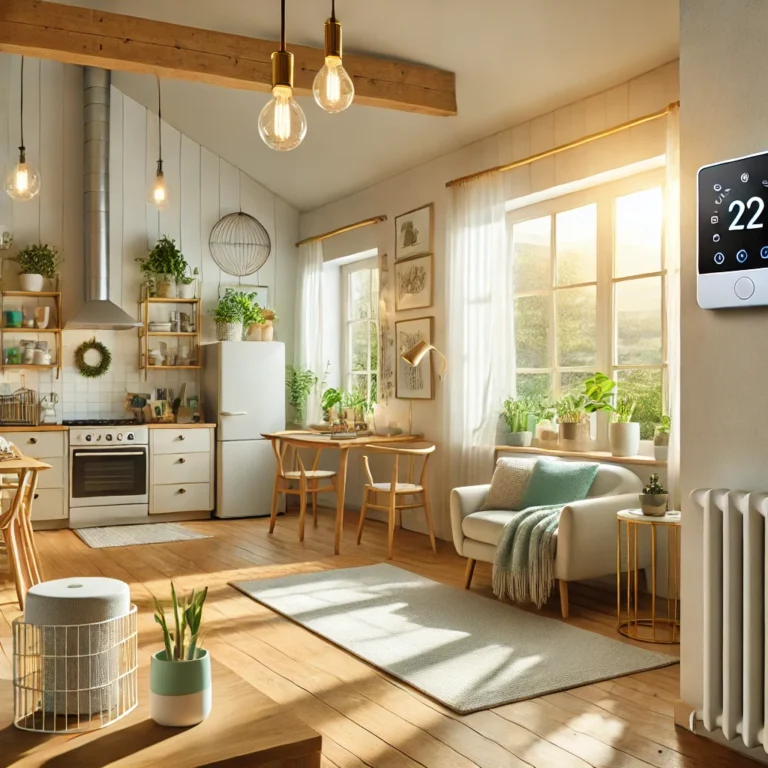Physical Address
304 North Cardinal St.
Dorchester Center, MA 02124
Physical Address
304 North Cardinal St.
Dorchester Center, MA 02124


Creating an energy-efficient home is one of the most impactful ways to reduce your carbon footprint while saving on energy bills. Whether you live in a large house or a small apartment, there are plenty of small, affordable changes you can make to improve energy efficiency. In this guide, we’ll cover practical tips that will help you turn your space into an eco-friendly home, saving both energy and money.
Improving home energy efficiency is essential for reducing greenhouse gas emissions and tackling climate change. According to the International Energy Agency, energy efficiency could account for over 40% of the greenhouse gas reductions needed by 2040. Not only does this benefit the environment, but it also offers long-term savings on your energy bills, allowing you to cut costs while enjoying a more sustainable lifestyle.
From small tweaks to larger upgrades, here are some globally relevant tips to make your home more energy-efficient.
Proper insulation is one of the most effective ways to keep your home warm in winter and cool in summer, reducing the need for excessive heating or air conditioning. Insulating walls, floors, and especially the attic can make a huge difference in energy usage. If full insulation isn’t feasible, try using thick curtains or draft stoppers around doors and windows to keep your home temperature steady.
In Canada, a homeowner insulated their attic and saw a significant decrease in heating costs, especially during the winter months. This simple adjustment made their home more comfortable and energy-efficient year-round.
Switching to energy-efficient light bulbs like LEDs or CFLs is an easy and cost-effective way to cut back on energy usage. These bulbs consume less power and last much longer than traditional incandescent bulbs. LEDs, for instance, use up to 80% less energy and can last 25 times longer, making them a great choice for both your wallet and the environment.
A family in Japan replaced their old light bulbs with LEDs and reported not only lower electricity bills but also a noticeable reduction in their energy consumption, an easy and affordable step toward a greener home.
When it’s time to replace an appliance, look for models with high energy-efficiency ratings, like those with the Energy Star label. Energy-efficient appliances use less electricity, water, or gas, and often include advanced features that maximize performance while minimizing waste. Appliances such as refrigerators, dishwashers, and washing machines can consume significant energy, so opting for energy-efficient versions can make a big difference.
A couple in Australia switched to an Energy Star-rated washing machine and dryer, resulting in about 25% savings on their energy bills. They also felt good knowing that their choice was a positive one for the environment.
Learn more about energy-efficient appliances on the Energy Star website, which offers information on the best energy-saving products.
A smart thermostat can make a big impact on energy efficiency by optimizing heating and cooling patterns based on your lifestyle. These devices allow you to adjust temperatures remotely and set schedules to avoid wasting energy when you’re not at home. They’re ideal for maintaining comfort while saving energy, especially if you live in a climate with extreme temperatures.
In the United States, a homeowner installed a smart thermostat, and after a few months, they noticed a 10% reduction in their heating and cooling costs. The thermostat automatically adjusted the temperature when the home was empty, preventing unnecessary energy usage.
Using natural light not only saves energy but also adds a bright and welcoming feel to your home. During the day, try to rely on sunlight rather than artificial lighting. Additionally, good ventilation can help regulate indoor temperatures, reducing the need for fans or air conditioning. Opening windows during cooler parts of the day or using cross-ventilation can naturally cool your home.
In Italy, a couple redesigned their home layout to maximize sunlight exposure in commonly used rooms, cutting down on the need for artificial lighting and making their space feel more open and inviting.
Explore more tips on natural lighting and home design strategies that improve energy efficiency from Green Building Advisor.
Marta, an eco-conscious homeowner in Spain, decided to take a closer look at her home’s energy usage. She started by switching to energy-efficient lighting and then insulated her windows and doors. She also added a smart thermostat and upgraded her old refrigerator to an energy-saving model. These adjustments reduced her energy bill by around 20% over the year and made her home a more comfortable and eco-friendly space.
Have you tried any of these energy-efficient home tips? Making small changes can add up to substantial savings and a lower environmental impact. Whether you’re swapping out light bulbs or investing in smart home technology, there are plenty of ways to create a greener, more energy-efficient home.
What are your favorite energy-saving tips? Share them with us, and let’s inspire each other to live more sustainably every day!